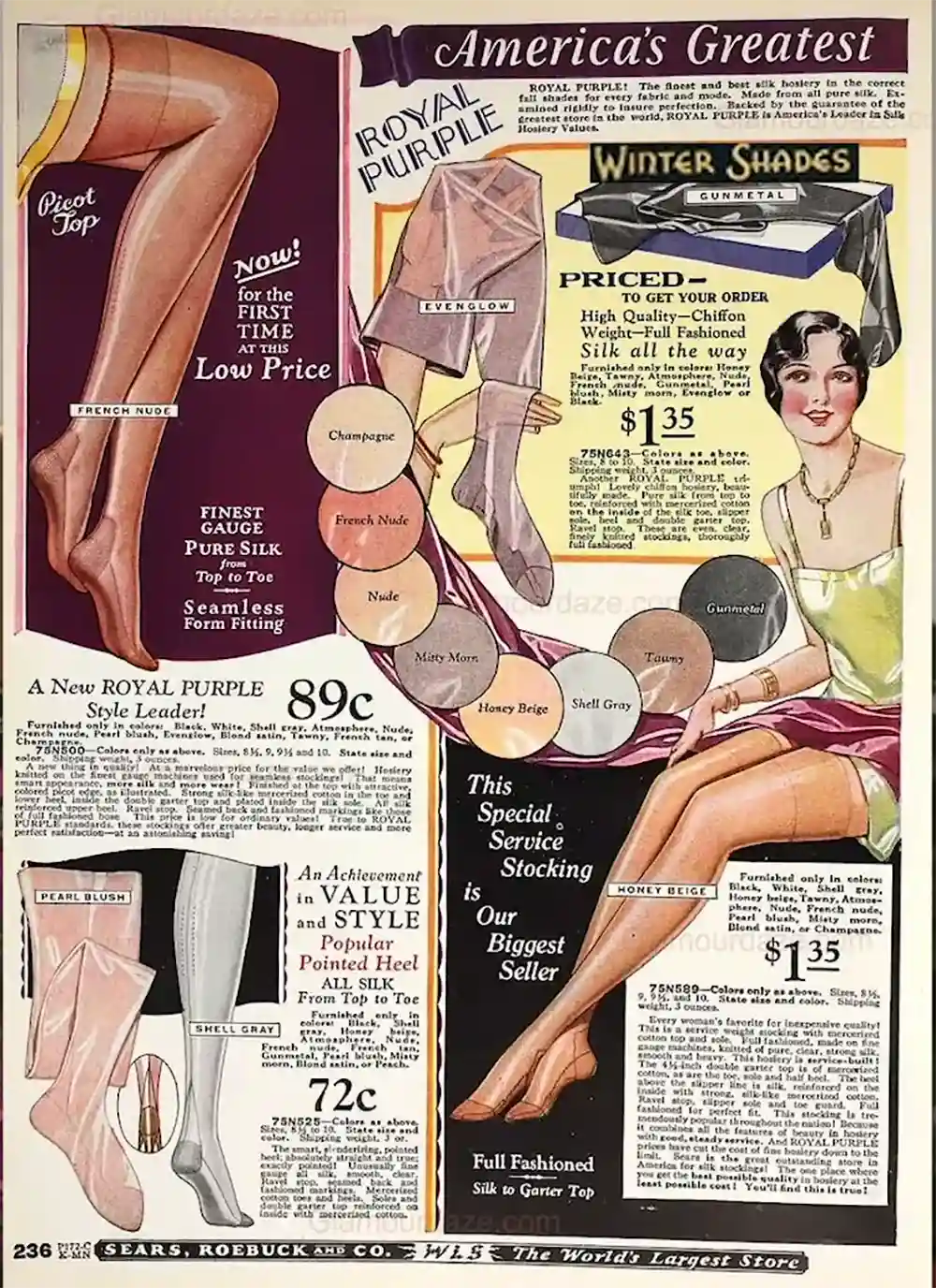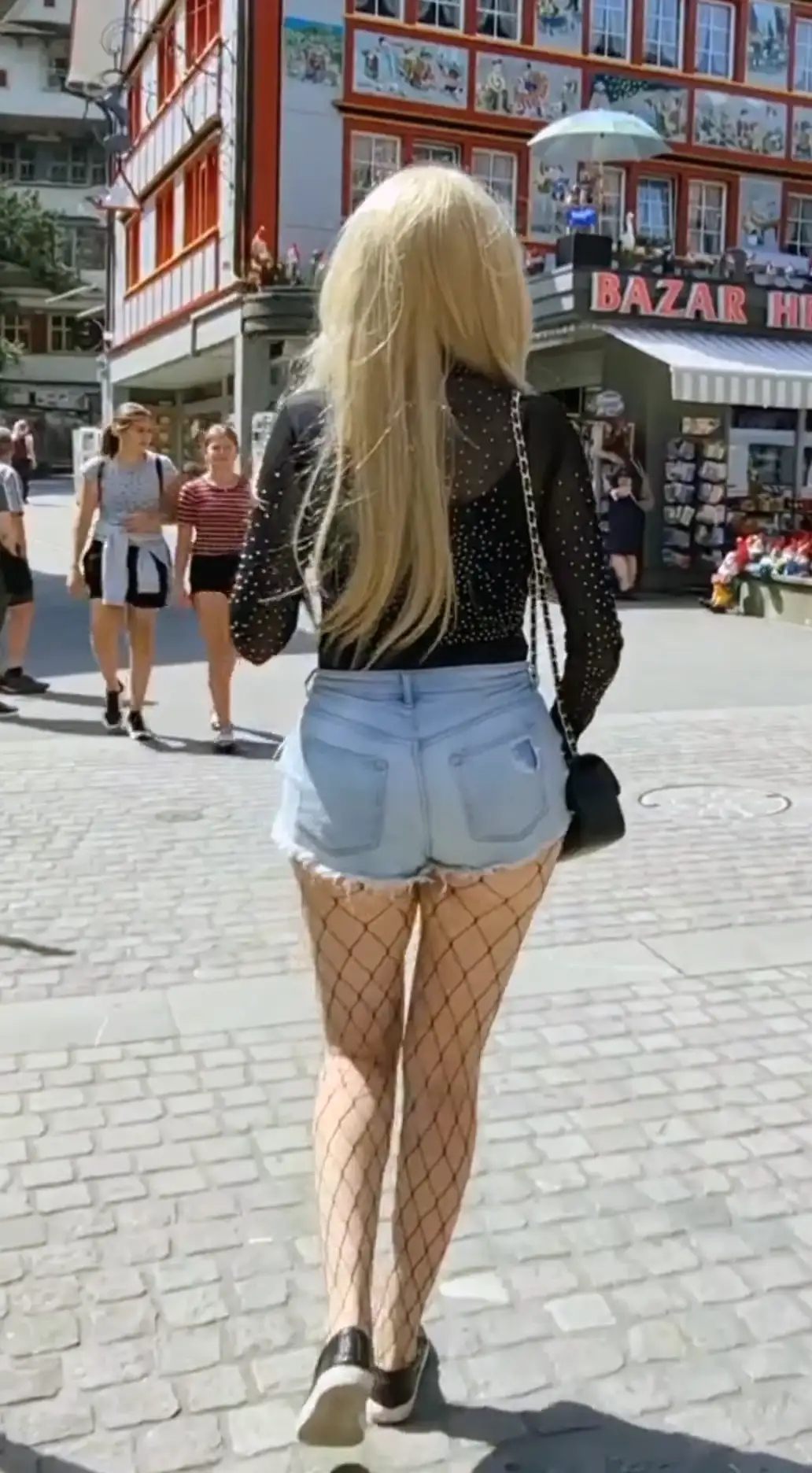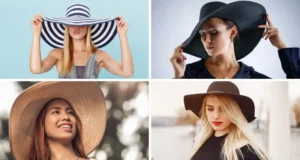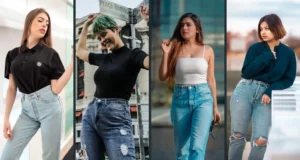Fishnet stockings have cycled in and out of popularity for nearly a century now. But some periods saw greater favor for fashion than others.
The 1920s flapper era was the first time fishnets became very well-liked. Flappers and showgirls wore fishnets a lot during that time period. Fishnets matched perfectly with the rebellious and free spirit of the flappers.
Fishnets remained somewhat stylish through the 1930s and 1940s. Performers like burlesque dancer Gypsy Rose Lee wore fishnets on stage. But fishnets did not become truly standard fashion until the 1940s and 1950s.
Pin-up models like Betty Grable made fishnets incredibly popular in the 1940s. Movie stars like Elizabeth Taylor and Marilyn Monroe often wore fishnets in the late 1940s and 1950s. So more and more women started to wear fishnets as just usual stockings.
Punks and goths adopted fishnets in the 1970s and 1980s as part of their rebellious styles. Musicians like Madonna also made fishnets fashionable again from the 1980s onward.
Fishnet has often become trendy when youth cultures want to show opposition to society’s rules. But once movie stars and designers take up fishnets, they become a more general fashion. Fishnets have a history of representing freedom and female sensuality. So even after 100 years, fishnets remain a beloved look.
Why were fishnet tights invented?
Fishnet tights are made of an open cloth that helps air to pass through. This makes them more relaxed to wear, especially for performers who are active on stage.
The open pattern of fishnet tights lets some skin show, giving the wearer an attractive and alluring look partly uncovered. This seemed showgirls, burlesque dancers, and other performers who wanted to emphasize their sexual attraction.
Before synthetic fibers like nylon were invented, fishnet tights were made from real or netting materials. This was a useful and inexpensive choice that still presented some leg coverage.
Fishnet tights have long been connected to fetish and sexual cultures due to their revealing nature and ability to recommend nudity without fully revealing the body. This loans a sense of attractiveness and sexuality to the style.
Like most fashion trends, fishnet tights were initially created to fulfill a need or practical purpose. But they rapidly became attached to style, glamour, and the aesthetics of performances and nightlife. This transformed them into a fashion statement.
In summary, fishnet tights were started chiefly for practical reasons like breathability and affordability. But their revealing look, sexuality symbolism, and connection with performances and fashion helped transform them into a style symbol that has moved in and out of mainstream popularity for decades.
Fishnet tights were invented in the late 1800s as an alternative to regular stockings and tights.

Some of the reasons they were invented include:
- To provide coverage while still showing some skin: Fishnet tights allowed women’s legs to be partially visible while still maintaining modesty according to Victorian standards.
- For breathability: The open mesh fabric of fishnet tights allowed air to circulate, making them cooler and more comfortable to wear.
- For dancers and performers: Fishnet tights were adopted by dancers and performers who needed a practical stocking that allowed leg movement.
- As a fashion statement: Over time, fishnet tights became associated with countercultures and subcultures, representing fashion, rebelliousness, and sexuality.
- From cheaper materials: Early fishnet tights were often made from actual fishnet or another type of netting material, providing an inexpensive option.
Did they wear fishnets in the 30s?
Yes, women did wear fishnet stockings in the 1930s but not as much as in later decades. Fishnets in the 1930s were mainly connected to performers, not standard fashion.
Performers and showgirls mostly wore fishnets in the 1930s. Fishnet stockings were connected to the stage and show still. Burlesque dancers, cabaret performers, and other entertainers typically wore them.
Fishnet stockings had a slightly unsuitable picture in the 1930s. As performers largely used fishnets, they had an image as a bolder and more suggestive fashion choice. They were thought to emphasize a woman’s legs and form.
Fishnet stockings were a specialty thing in the 1930s. Though fishnet stockings gained some popularity, they had not completely entered the mainstream yet. Non-transparent stockings stayed more standard for everyday wear.
Some actresses like Marlene Dietrich and Jean Harlow wore fishnet stockings in Hollywood, especially in more glamorous or suggestive roles. This helped spread fishnet stockings’ fashion influence bit by bit.
Fishnet stockings were made of synthetic fibers in the 1930s. Nylon, which emerged in the late 1930s, enabled the mass production of more hardworking fishnet stockings. This helped spread availability.
In conclusion, though fishnet stockings existed in the 1930s, they were chiefly used by performers and the more fashion-forward women. They had a more unsuitable image and were not completely mainstream yet. But things like Hollywood, new fabrics, and wider availability set the stage for larger popularity in the following decades.
Were fishnets popular in the 50s?
Yes, fishnet stockings were a well-liked fashion item in the 1950s. They became a standard fashion for numerous causes.
Fishnet stockings went with the pin-up culture very well. Pin-up models and Hollywood stars like Marilyn Monroe and Elizabeth Taylor usually wore fishnets. This helped fishnets become standard and regular for the general population.
The American economy did very well in the 1950s after World War II. So, buyers had additional money and took on fashion trends like fishnets. They created a cheap sense of women’s sensuality and femininity that drew in many women.
The increase in teenage consumers in the 1950s meant young women, particularly, took on styles like fishnets to show their growing independence and sexuality.
After the war, advances in manufacturing and stores made stockings, like fishnets, more widely accessible at cheap prices. This helped force their mass adoption.
Fishnets began to be seen as a representation of sex appeal, allure, and glamour during this era. Magazines, advertisements, and films made this connection more strong.
In summary, between the impact of Hollywood, the rise of pin-up culture, financial success, increased availability, and their symbolism of sex attractiveness – fishnet stockings turned out to be quite popular among women of all ages during the 1950s. They found their place as a general fashion staple during this decade.

Were fishnet stockings popular in the 70s?
Yes, fishnet stockings were well-liked in the 1970s. Punks and other groups often wore them, becoming a symbol of rebellion and nonconformity. Fishnets were also seen as a way to show sexuality and power.
The punk subculture made fishnet stockings popular. Punks saw fishnets as a method to show their rebellious and nonconforming natures. Punks often wore fishnets with torn clothes, chains, and other rebellious accessories.
Fishnet stockings were also seen as a method to show sexuality and power. The fishnet pattern lets a glimpse of skin, which could be seen as a way to be provocative and attractive. Women wore fishnets to feel in power and in control.
Fishnets were fashionable in the 1970s too. They were frequently seen in fashion magazines and celebrities, which helped make them more trendy.
The emerging goth subculture also adopted fishnets as part of their free, sexually liberated aesthetics. Fishnets conveyed goths’ nonconformity to mainstream society.
The sexual revolution and women’s liberation made revealing and different styles more approved. With their long history as lingerie, Fishnets fit right into this new context of sexual freedom.
The rise of disco culture in the mid to late 1970s made revealing and sexy styles trendy. As part of this trend toward more skin exposure, fishnets became standard fashion during this era.
Pop and rock stars like David Bowie and Cher made fishnet stockings popular among the overall public. Their influence helped move fishnets into the mainstream.
More obtainable manufacturing and retail choices made fishnets a reasonable style for the masses in the 1970s. This helped drive their increasing recognition.
In summary, while countercultures first adopted fishnets as a symbol of rebellion, social attitudes changed, and cultural trends and availability all contributed to fishnet stockings gaining wider popularity in the general 1970s style.
Were fishnets popular in the 90s?
Yes, fishnet stockings were popular in the 1990s, though not as mainstream and trendy as in past decades. Fishnets stayed fashionable for many reasons in the ’90s.
A retro revival happened in the 1990s. This revived retro and vintage styles, such as the 1940s and 1950s pin-up style. Fishnet stockings, a key part of that earlier period, matched up with this retro trend properly.
Alternative youth cultures like grunge, rave, and goth carried on embracing fishnets as a symbol of rebellion and nonconformity. Fishnets kept linked with these countercultures.
Major pop stars of the ’90s, like Britney Spears, Madonna, and Gwen Stefani, were frequently photographed wearing fishnet stockings. This helped spread the style to the mainstream audience.
Fishnets kept their image as an attractive and alluring fashion choice. They carried on symbolizing appeal and femininity. This sex appeal made them somewhat trendy.
Fishnet stockings became available in a wider range of colors, styles, and materials in the 1990s. This helped keep them interested and make them seem modern.
The emergence of neo-burlesque in the 1990s meant fishnet stockings, as a classic part of the burlesque costume, became trendy again. This revived their popularity.

How did fishnet stockings become associated with punk and goth fashion?
Fishnet stockings connected well with punk and goth fashion for various causes.
Punk and goth cultures wanted to rebel against normal society. Fishnets, with their sexual meanings, became a symbol for this rebellion quickly.
Many punks and goths in the 1970s made style from used and cheap items. Fishnets were inexpensive and easy to change, tear and layer differently. This matched the punk style well.
Both punk and goth cultures accepted sexual freedom more. Fishnets, with a history as a symbol for sexuality and fetish wear, fit in this different view of sexuality truly.
By the 1970s, fishnets were already connected to groups like bikers, sex workers, and club visitors. Punks and goths adopted the style to link to these subgroups.
British fashion designer Vivienne Westwood made fishnet tights an essential part of punk fashion during that time period. She made sure fishnet tights were a key part of her punk designs.
In short, fishnet stockings represented the rebellious, homemade, and sexually free thoughts of punk and goth cultures completely. Their unconventional meanings and ability to change made them a perfect symbol for these emerging youth movements.
After all, here is the list of key reasons why fishnet stockings became associated with punk and goth fashion:
- Symbol of rebellion
- Both punk and goth cultures rebelled against mainstream culture and values. With their suggestive and taboo connotations, Fishnet stockings made a natural symbol of this rebellion.
- DIY aesthetic
- Many punks and goths in the 1970s and 80s made their own style from affordable, secondhand items. Fishnets were cheap and easy to customize, tear, and layer in unconventional ways. This fits the DIY punk aesthetic.
- Sexual liberation
- Both punk and goth cultures embraced sexual freedom and fluidity. Fishnet stockings, with their history as a symbol of sexuality and fetish wear, fit right into this alternative view of sexuality.
- Association with subcultures
- By the 70s and 80s, fishnets were already associated with groups like bikers, sex workers, and clubgoers. Punks and goths adopted the style to associate themselves with these subcultures.
- Vivienne Westwood
- British fashion designer Vivienne Westwood popularized fishnets in punk fashion during this time. She ensured fishnet tights were a staple of her punk designs.

Summary
Fishnet stockings have a fascinating history, cycling in and out of popularity for almost a century. The 1920s flapper era marked their initial rise, as flappers and showgirls embraced the rebellious spirit of fishnets. In the following decades, fishnets remained somewhat stylish, with burlesque dancers and movie stars like Betty Grable, Elizabeth Taylor, and Marilyn Monroe, and many more contributing to their popularity.
In the 1970s and 1980s, fishnets found a new home in punk and goth fashion, symbolizing rebellion and nonconformity. Musicians like Madonna further elevated their status. Fishnets have often represented freedom and female sensuality, making them beloved throughout history.
The invention of fishnet tights in the late 1800s aimed to provide coverage while still showing some skin, enhance breathability, and cater to the needs of dancers and performers. Over time, they transformed into a fashion statement associated with style, glamour, and the aesthetics of performances and nightlife.
While fishnets were worn in the 1930s, their popularity was mainly limited to performers. In the 1950s, fishnets became a standard fashion, thanks to pin-up culture, Hollywood stars, and the economic boom. The 1970s saw fishnets embraced by punks and goths, representing rebellion and sexuality. In the 1990s, fishnets remained popular among alternative youth cultures and underwent a retro revival.
Overall, fishnet stockings have evolved, gaining wider recognition and acceptance while retaining their allure and timeless appeal.
FAQ
Are fishnets 80s?
Yes, fishnet stockings and clothing items were popular in the 1980s as a fashion trend. Pop stars and celebrities of the time were often seen wearing fishnet tights, shirts, and body stockings.
Are fishnets 60s?
Fishnet stockings and tights were a popular fashion trend in the 1950s and 1960s and were worn by classic beauties in that era.
Were fishnets popular in the 2000s?
Yes, fishnet stockings and clothing items were popular in the 2000s fashion, particularly towards the early and mid-2000s. They were often worn by celebrities and pop stars of the time and were associated with the punk and pop-punk music scenes.
When were fishnet shirts popular?
Fishnet tops first emerged in the 1980s and were favored by both men and women. They were often worn as statement pieces, paired with denim jackets, leather skirts, and colorful accessories. Fishnet shirts came back in the 1990s and were worn by goths, punks, and grunge fans.
When were fishnet gloves popular?
Fishnet gloves have been a popular accessory on and off since the 1980s. There are many different styles of fishnet gloves, including fingerless gloves, neon gloves, and mesh gloves, that different subcultures have favored throughout the decades.



